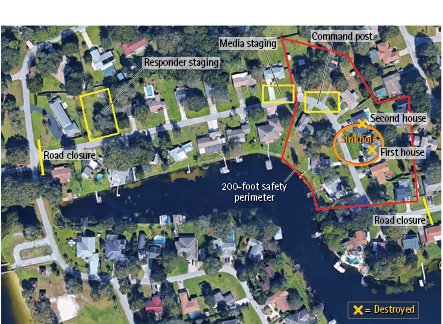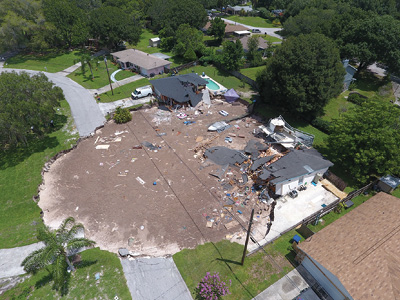
BY SCOTT M. CASSIN
Sinkholes are a relatively common occurrence throughout the United States, with those causing the most damage occurring in Florida and other states throughout the South and Midwest. A sinkhole occurs when naturally occurring groundwater flowing through soluble bedrock dissolves the rock layer below the surface, causing the soil above to sink or collapse, forming a depression. Although this is a fairly common and usually minor incident, incident readiness to an enlarging sinkhole tests the very foundation of an “all-hazard” fire service response.
Pasco County, Florida, lies in “Sinkhole Alley,” encompassing Pasco, Hernando, and Hillsborough counties in the Tampa Bay region of west central Florida, so responding to a sinkhole is a common call. Pasco County Fire Rescue (PCFR) receives several calls per year through its emergency communications center to respond to a potential sinkhole and to evaluate the conditions found. Once assessed, these sinkholes are generally referred to as a ground cover collapse until a geologist scientifically confirms it as sinkhole. There could be other possible reasons for the collapse, such as a water main break, improper construction techniques, or natural erosion. Unless a known life safety issue exists, these responses are typically performed as an investigation, a nonemergency response.
The Incident
July 21, 2017, was a typical morning, with the off-going shift members at Fire Station 23 readying their equipment and station for the oncoming crew that was due in by 8 a.m. At 7:21 a.m., a call was received reporting some sort of ground anomaly occurring on Ocean Pines Drive in the Land O’Lakes area. As the members responded, the mobile computer terminal indicated that a swimming pool-sized depression was occurring beneath a boat parked on the side of the home at that location. The scene was about nine minutes away with early morning traffic and a nonemergency response.
Figure 1. Overview of the Sinkhole Site

The incident setup from about two hours into the response. Initially, the command post, media staging, and general staging were adjacent to the sinkhole but were moved back as the sinkhole continued growing. (Figure courtesy of author.)
On Arrival
When the crew arrived, members found a quickly unfolding incident of the magnitude that none of the veterans had ever seen. The entire front of the Alpha-Bravo corner of a home had detached from the main portion of the structure and was literally falling into a large depression in the ground approximately 30 feet × 30 feet. It was filling with water, which was unusual. The crew members immediately radioed for additional assistance from the sheriff’s office as well as emergency management.
The crew members soon met the neighbors living next to the collapsing home. Despite the language barrier, the crew members ascertained that no one was home and that the occupants had left for work a little while earlier. The members proceeded to confirm this information, jumping the fence on the home’s Delta side to make access through a rear door of the home to conduct a search. On entering the home, they encountered two dogs, which were quickly removed to safety. Their continued search confirmed no further occupants. At this point, the crew, as in most catastrophic ground cover collapses, had surmised that the worst of the collapse was over.
When the crew members entered the home’s kitchen, they found that there were no front walls and that the front yard and street were openly visible. The structure was continuing to pop and crack, and it was determined that the anomaly was still active. The crew decided to vacate the structure.
On the way out, members noticed some vehicle keys hanging on the wall and took them to remove the three vehicles on the property. They secured utilities as they successfully removed a recreational vehicle from the Delta side and a sport utility vehicle in the driveway. However, they were unable to remove a vintage car and a motorcycle from the garage because of further signs of impending collapse. The depression had by then grown to at least 2,500 square feet from its original 900 square feet and had filled with water.

(1) Just after firefighters had evacuated, the first house suffered a partial structural collapse. (Photos by author.)
The hole was growing and was swallowing everything in its path. The house buckled, continuing to break away as the palm trees disappeared into the hole. Because the hole appeared to be advancing on three of the four sides, neighboring homes were evacuated. The Bravo 1 exposure was closest to the hole and was evacuated first. The residents were able to retrieve several dogs, their medications, passports, and a laptop computer before large cracks started forming on the Delta-Alpha corner of the home’s exterior. Assisted by sheriff’s office personnel, the responders evacuated homes, working from the most endangered exposures circumferentially outward. In all, 10 other homes were evacuated as an approximate 200-foot safety perimeter was established.
Once the members had addressed all life safety and utility concerns and cordoned off the entire perimeter with scene tape, they could do nothing more than wait and watch. After about seven hours, the hole finally slowed its advance but not before growing to more than 40,000 square feet, consuming two homes, and leaving up to 10 other homes with a high likelihood of condemnation because of structural anomalies that had appeared (popped floor tiles, cracks in walls, and doors that would no longer shut properly—all signs of shifting ground beneath the homes).
Although this incident proliferated to include a multitude of government and private agencies, this article focuses on the fire service response and mitigation and lessons learned.
Long-Term Incident
It quickly became evident that this incident would likely span several weeks. The incident’s uniqueness necessitated long-term maintenance needs such as scene security, lighting, portable restrooms, a command post, media staging, food service, vehicle/generator fuel, and so forth.

(2) The initial news media staging location just outside the sinkhole perimeter.
Media Briefings
Holding regular media briefings and maintaining the flow of information were critical to the incident’s success. Media outlets nationwide began descending on the area, wanting to capture video, audio, and commentary. The incident occurred deep in the middle of a suburban neighborhood with narrow streets and no sidewalks. This presented tremendous traffic control concerns early on: The streets leading up to the involved area became clogged with emergency response vehicles, media, and concerned citizens. Even after vehicle parking was limited to only one side of the street, the narrow pavement made it difficult for vehicles simultaneously entering and exiting to pass each other, which led to yard damage along home-front utility easements. Because of traffic difficulties, the command post was moved to a vacant lot about a quarter mile down the road.
After PCFR requested permission from a nearby homeowner, a forward media staging area was set up in his front yard. Media representatives were asked to park their vehicles farther away and walk personnel and equipment to the staging site. Roadblocks were established about one-quarter mile farther, from where only responders, media, and residents living inside the roadblock were permitted.

(3) The sinkhole as seen from 100 feet above the ground at its largest extent, showing the destruction of two homes.
Media outlets’ requests for aerial footage came fast and furious. Although not unusual with today’s technology, the sheer number of requests for drone footage was somewhat new. They needed to be coordinated because of a vast number of television news helicopters and law enforcement air support in the area. As a result, drone pilots were required to remain below 400 feet. Early in the incident, Pasco County Emergency Management had requested a no-fly zone within a half mile directly above the sinkhole because of an ever-increasing aircraft count in the area.
Kevin Guthrie, Pasco County’s assistant administrator for public safety, provided media briefings. Guthrie assembled a team of professionals to address the many facets of the unfolding incident. These briefings provided critical situational awareness for the media, the various agencies, and the contractors working at the scene. The county public information office provided one central point of information flow. This was set up almost immediately after realizing the scope of the incident and was a critical factor in ensuring the success of incident management with respect to the media.
Early involvement of emergency management was also essential to the success of the incident action plan. With an extended response and recovery likely, the volume of resource requests and robust interagency collaboration required the deployment of emergency management leadership and resources.
PCFR maintained a daily presence on site during the first week after the initial response. Special operations crews from Pasco County and the surrounding area conducted training exercises ranging from structural collapse to water rescue inside the sinkhole. The special operations training worked through rescue scenarios in anticipation of mitigation contractors working in and around the sinkhole area over the coming weeks to remove all the debris.
Afterward
The county hired a contractor to come in a few weeks after the hole was deemed fully stabilized and no longer growing (about 48 hours after the initial collapse). Heavy equipment removed most of the accessible debris above ground and in the 50-foot-deep water. Some is buried beneath a heavy silt layer at the bottom of the hole and is too costly to remove. After removing the debris, the county built a berm around the hole’s perimeter to shore up the edges. Some mitigation options included filling it in completely, building a bridge to reconnect the roadway, or leaving it as a lake and building cul-de-sacs at the end of each roadway stub. No decision has been made yet.
Lessons Learned
The lessons learned at this incident will enable us to better prepare for future events. In this incident, early execution of a formal unified command and a clearly defined incident action plan were paramount to overall incident management success. Particularly important were the media briefings and timely situational awareness updates provided to the residents and concerned citizens. Furthermore, maintaining scene security, managing the flow of personnel in and out of the area, and providing media and civilian accommodations in the form of designated and secure staging areas were also critical, especially in the early days of the event.
SCOTT M. CASSIN is a 31-year veteran of the fire service and has been the chief of Pasco County (FL) Fire Rescue since 2012. He has a master’s degree in business management and has been designated as a Chief Fire Officer by the Center for Public Safety Excellence.

